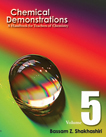
Order Volume 5 from Educational Innovations
Order Volume 5 from the University of Wisconsin Press

"...especially valuable for new teachers looking for an authoritative source for reliable and meaningful demonstrations" ...read more
"...a must for the classroom, library, and chemistry club at both the high school and collegiate levels" ...read more
"...extremely classroom-friendly" ...read more
"...sure to be another milestone in the history of chemical education"
...read more
"...the quintessential resource that every chemistry department may rely upon"
...read more
"...helped innumerable times to inspire and engage our [museum] visitors through the beauty and wonders of chemistry" ...read more |
Color, Light, Vision, Perception
This new volume brings color and light to the forefront, describing demonstrations that effectively communicate science both to students and to general audiences. The author and his collaborators Rodney Schreiner and Jerry Bell provide detailed instructions both for displaying colorful phenomena and illustrating scientific principles, and they describe what happens when visual information enters the human eye and is perceived by the brain.
With over 50 demonstrations and multiple procedures this volume sets new goals and expectations for arousing and sustaining interest in chemical transformations. Also included is a rich introductory section that explains the science of color and light and outlines the chemical processes of vision and the effects of visual stimuli that lead to perception.
Each demonstration includes seven sections: a brief summary, a materials list, a step-by-step account of procedures to be used, an explanation of the hazards involved, information on how to store or dispose of the chemicals used, a discussion of the phenomena displayed and principles illustrated by the demonstration, and a list of references. As in all volumes in the series, this book aims to communicate chemistry by using pedagogical knowledge to enhance effectiveness of classroom and public presentations.
The book was published in February 2011 by the University of Wisconsin Press.
View the Informational Flyer (2.39MB PDF)

In this series of practical handbooks, Prof. Bassam Z. Shakhashiri
and collaborators describe a wide range of demonstrations
for displaying chemical phenomena in science classrooms at
all levels. The demonstrations are grouped into topical chapters,
and each chapter includes an introduction which provides information
about the concepts, terminology, and principles related to
the demonstrations. The demonstrations themselves are divided
into seven sections:
- A brief description
gives a succinct overview of the demonstration.
- A list of materials
carefully itemizes everything you need to perform the demonstration,
including chemicals, laboratory equipment, and other supplies.
- The procedure
section provides step-by step instructions for preparation
and presentation of the demonstration.
- The hazards
section details the specific potential dangers of every
hazardous chemical used in the demonstration and, where
appropriate, additional potential hazards associated with
the demonstration.
- The disposal
section provides information about discarding or storing
the chemicals used in each demonstration.
- The valuable
discussion section for each demonstration provides, often
in considerable detail, the chemical phenomena and principles
illustrated by each demonstration. If includes appropriate
chemical equations and quantitative data. These analyses
enhance the book's usefulness by facilitating the teacher's
explanations of the phenomena that occur in the demonstrations.
- A list of references
details sources of additional information.
For contents of
each volume, click on its image above.
The series is also
being translated into Japanese.